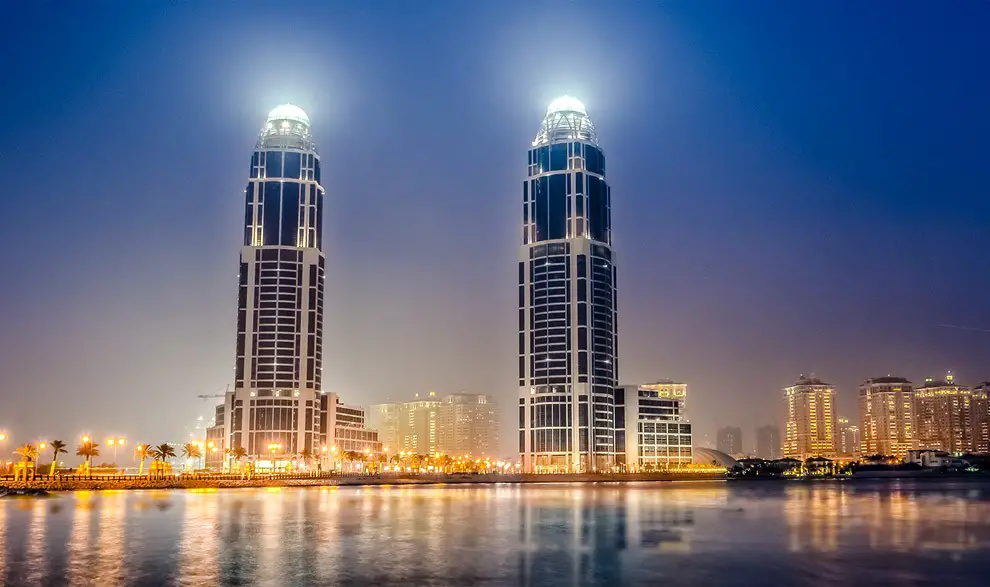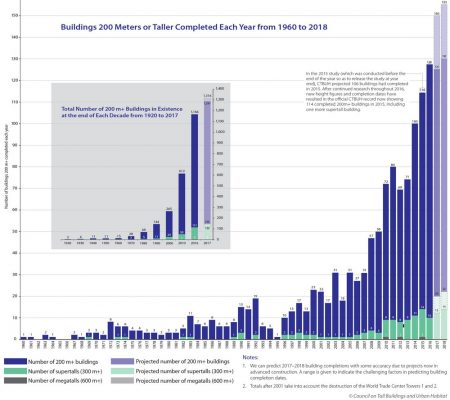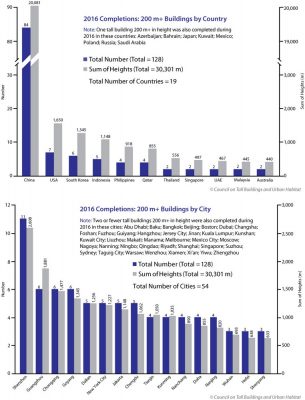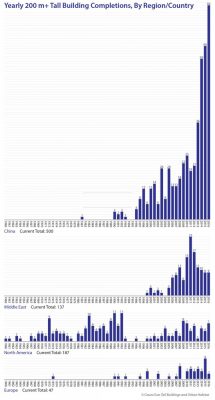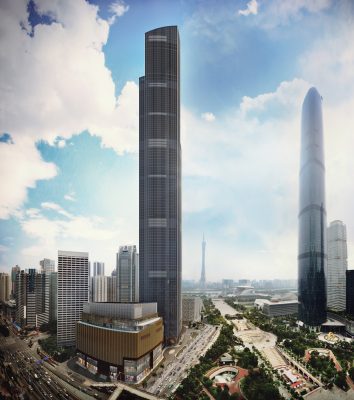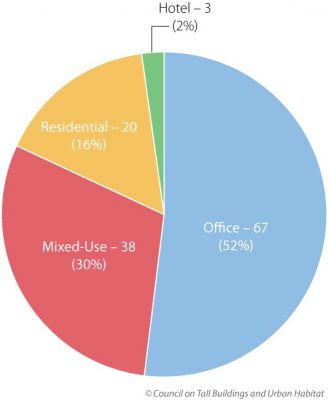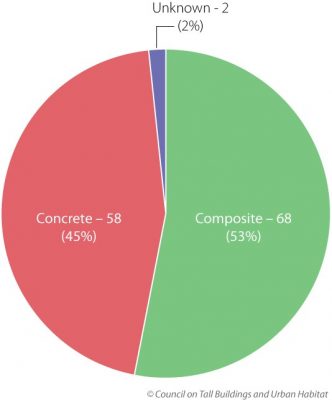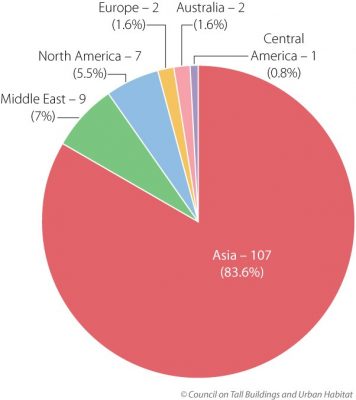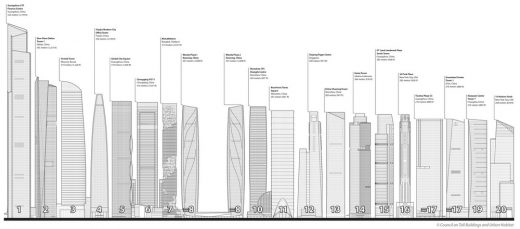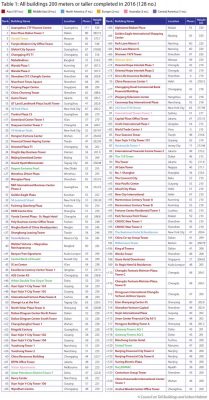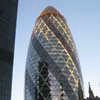CTBUH Annual Review in 2016, Tall Building Construction Trends, Projects News, New Skyscraper Designs, Image
CTBUH Annual Review 2016
Tall Building Construction Trends – Tower Architecture: International Skyscraper News
13 Jan 2017
CTBUH Awards annual review of tall building construction trends for 2016
CTBUH – 2016 a Record Year for Tall Buildings
The Council on Tall Building and Urban Habitat (CTBUH) has released its annual review of tall building construction trends for 2016.
The year was notable for having 128 buildings of 200 meters’ height or greater complete around the world – setting a new record for annual tall building completions. There were also eighteen 200-meter-plus buildings completed that became the tallest in a city, country, or region.
2016 Another Record-Breaker for Skyscraper Completions; 18 “Tallest Titles” Bestowed
CTBUH Year in Review: Tall Trends of 2016
Report by Jason Gabel, CTBUH; Research by Annan Shehadi, Shawn Ursini, and Marshall Gerometta, CTBUH
The Council on Tall Buildings and Urban Habitat (CTBUH) has determined that 128 buildings of 200 meters’ height or greater were completed around the world in 2016 – setting a new record for annual tall building completions and marking the third consecutive record-breaking year.
Gateway Towers Complex:
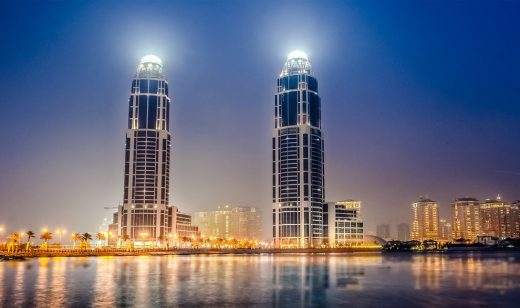
(c) KEO
Further Highlights:
ƒƒThe 128 buildings completed in 2016 beat every previous year on record, including the previous record high of 114 completions in 2015. This brings the total number of 200-meter-plus buildings in the world to 1,168, marking a 441% increase from the year 2000, when only 265 existed.
ƒƒThere were eighteen 200-meter-plus buildings completed that became the tallest in a city, country, or region.
ƒƒA total of 10 supertalls (buildings of 300 meters or higher) were completed in 2016, fewer than we anticipated this time last year, partly as a result of construction delays typical of buildings in this height range. Nonetheless, 2016 still saw the third-largest number of supertall completions of any year, trailing only 2015, which saw 14; and 2014, which saw 11.
ƒƒThe tallest building to complete in 2016 was Guangzhou CTF Finance Centre, which stands as the tallest building in Guangzhou, the second-tallest building in China, and the fifth-tallest building in the world at 530 meters.
Asia retained its status as the world’s skyscraper epicenter in 2016, completing 107 buildings, representing 84% of the 128-building total.
ƒƒThe Middle East matched its 2015 numbers with nine completions in 2016, with North America experiencing a slight increase this year, up from four completions in 2015 to seven in 2016.
ƒƒFor the ninth year in a row, China had the most 200-meter-plus completions, with a record 84, overtaking by 24% its previous annual record of 68 in 2015.
Kingold Group Zhujiang New Town:
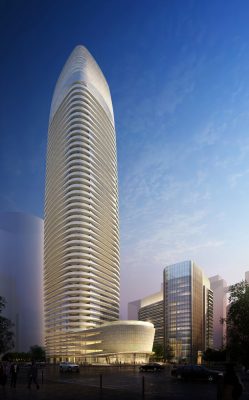
(c) Crystal CG
The United States completed the second-most 200-meter-plus buildings with seven, a notable increase over the two buildings completed in 2015. Meanwhile, South Korea made the list with six completions, with Indonesia seeing five, and both the Philippines and Qatar completing four.
ƒƒShenzhen had the highest number of 200-meter-plus completions of any city in 2016 with 11 (more than any country other than China managed to complete), while China’s Chongqing and Guangzhou, and Goyang, South Korea tied for second place with six each. The total height of buildings completed in Shenzhen is 2,608 meters.
CTBUH Annual Review – Key Worldwide Market Snapshots of 2016
Asia (Not including Middle East)
The momentum of Asia has been unyielding for many years, and 2016 only serves to further reinforce this trend. The region recorded 107 of the 128 completions for the year, or 84% of the total. A majority of these buildings are located in China, which completed the most 200-meter-plus buildings (84) of any country in the world.
This was the ninth year in a row that China achieved this distinction. Thirty-one cities in China had at least one 200-meter-plus building completion, with Shenzhen outperforming any other city in the world, with 11. Trailing behind Shenzhen are Chongqing and Guangzhou, each with six completions; followed by Chengdu and Dalian with five apiece.
The tallest building to complete in 2016 was Guangzhou CTF Finance Centre, a 530-meter landmark tower in Guangzhou that, together with Guangzhou IFC, completes a binary framing of the skyline long envisioned and debated by local urban planners. The tower is now the tallest building in Guangzhou, the second tallest in China (and Asia), and the fifth tallest building in the world. In a fortunate turn of events, delegates at the CTBUH 2016 Conference were some of the first official occupiers of Guangzhou CTF Finance Centre, as the building was the location of both the core conference city program and a networking reception.
Nanjing Financial City Tower:
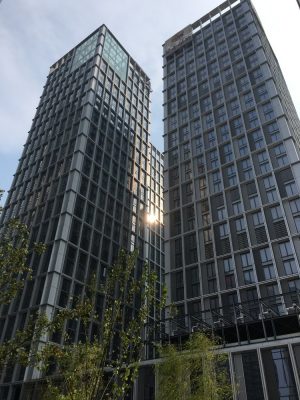
(c) gmp architekten
Ningbo Bank of China tower:
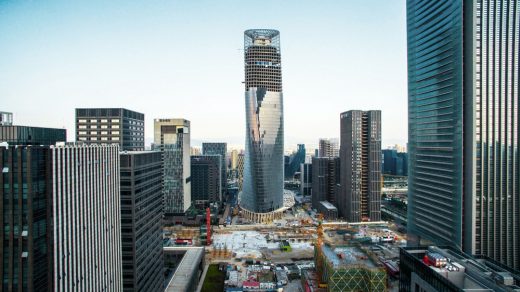
(c) Ningbo Eastern New City Development Investment Co. Ltd.
GT Land Landmark, Guangzhou, Guangdong, China:
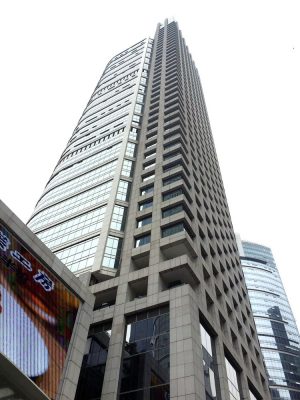
(c) Woods Bagot
South Korea finished the year with six 200-meter-plus completions, ranking third by country and doubling its 2015 count of three. All six of the towers completed this year belong to the Ilsan Yojin Y-City Complex in Goyang, with towers ranging from 214 to 230 meters.
Following on its success as having completed the most 200-meter-plus buildings by city in 2015, Indonesia came in just behind South Korea with five completions in 2016, all of which are located in the capital of Jakarta. At 286 meters, Gama Tower was the tallest building to complete in the country, snagging the top ranking for both Jakarta and Indonesia at large.
ƒƒGama Tower, Jakarta:
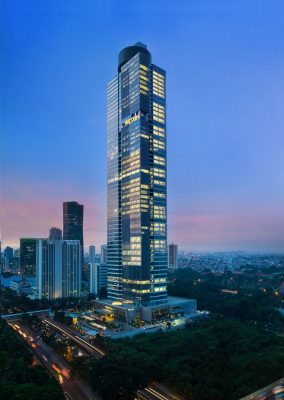
(c) Westin
The Philippines had four 200-meter-plus completions, a respectable increase over its 2015 count of just one. The completions were split between Taguig City and Makati, each with two. The tallest building to complete was the Grand Hyatt Metrocenter in Taguig City, which is now the second tallest building in the Philippines.
Shangri-La at the Fort tower, Manila, Philippines:
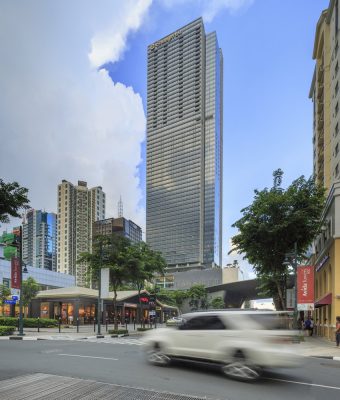
(c) Jay Jallorina
Oasia Downtown, Singapore:
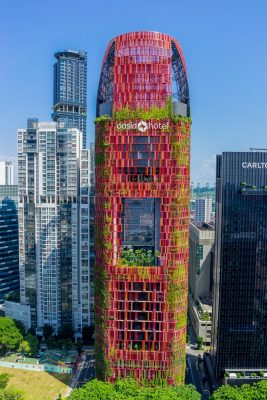
(c) K. Kopter
Shenzhen CFC Changfu tower:
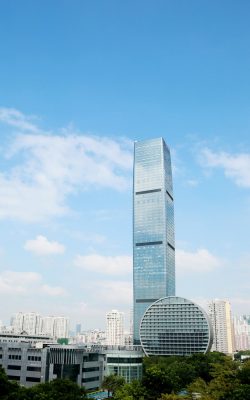
(c) Cheng Chen
The Tower building:
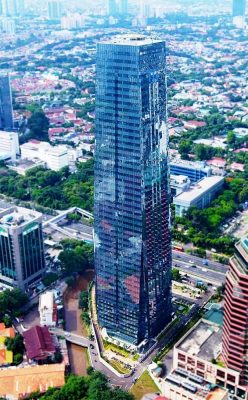
(c) Davy Sukamta & Partners
Middle East and Africa
While Africa has yet to see a 200-meter-plus completion since 1973, for the second year running, the Middle East ended the year with nine such completions. This continues a steady trend of completions in the region, but pales in comparison to its all-time high of 23 in 2013, a spike that was attributed to a global post-recession recovery in tall building construction. 2016 was the first year since 2006 that the Middle East has not seen the completion of a supertall (300-plus-meter) building, but one should be wary of assuming that this is indicative of a regional swing away from the supertall height threshold. Optimistic projections show as many as nine supertall buildings completing in the Middle East in 2017.
Emirates Pearl Hotel tower:
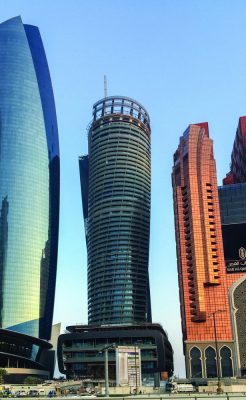
(c) DeSimone Consulting Engineers
In an unusual turn, the United Arab Emirates did not have the greatest number of completions in the region for the year. That accomplishment belongs to Qatar, which saw four towers completed in 2016. The UAE followed with just two completions, and Saudi Arabia, Kuwait, and Bahrain tied with one completion each. The tallest building to complete in 2016 in the Middle East is Regent Emirates Pearl, a 255-meter tower in Abu Dhabi that twists along its height at a rate of approximately 0.481 degrees per floor. The tower was featured in the online version of the CTBUH Tall Buildings in Numbers study, Twisting Tall Buildings.
North America
Bouncing back from just four completions in 2015, North America saw the finalization of seven 200-meter-plus buildings in 2016, the greatest number since 2010, in which it also had seven. All of these buildings are located within the United States, and four are in New York City alone. Most of the buildings completed in the US were residential in function, with six of the seven incorporating living components, and just one incorporating office uses (10 Hudson Yards, 268 meters).
ƒƒ30 Park Place tower:
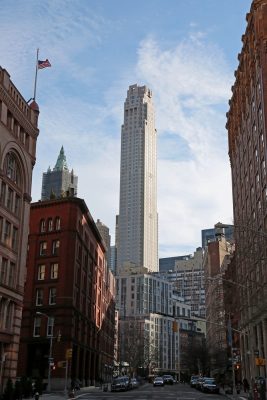
(c) Joe Woolhead
The tallest building to complete in the US was 30 Park Place, a 282-meter residential / hotel tower in Downtown Manhattan, accommodating a Four Seasons Hotel in the lower portion and luxury apartments above the 40th floor. Notably, the year also saw the opening of 56 Leonard Street, a tower that has been tracked closely throughout its development by the media, given its unique “Jenga-like” design that extrudes upper-level penthouses on cantilevering floor slabs.
Europe
Despite having a significant influx of tall building completions in 2015, 2016 saw the lowest number of 200-meter-plus completions in Europe (two) since 2009, in which it had zero. Notably, the year saw the completion of the 374-meter Vostok Tower, Moscow, the tallest component of the Federation Towers complex.
Warsaw Spire building:
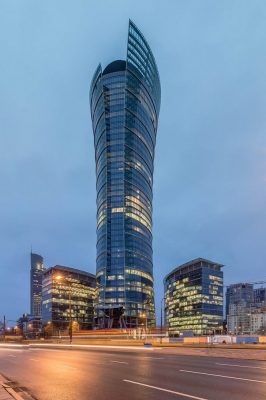
(c) UNK Ghelamco
After starting construction in 2005, the tower has been 11 years in the making. It is now the tallest building in Europe, a title that previously belonged to OKO Residential Tower, a development that completed in 2015 just blocks away from Vostok Tower in the Moscow City district. The other notable completion was Warsaw Spire, a 220-meter tower that represents the tallest of several new projects recently rising in the Polish capital. In terms of its height on the Warsaw skyline, the tower ranks second only to the Soviet-era Palace of Culture and Science, built in 1955.
Australia
The land down under boasts two completions in 2016, Vision Apartments in Melbourne at 223 meters and International Towers – Tower 1 in Sydney at 217 meters. The annual trickle of tall buildings coming online in the country is expected to continue in the years ahead, with eleven 200-meter-plus buildings currently under construction or topped out, with completion years ranging from 2017 to 2020.
Central America
The Central America region had only one 200-meter-plus completion in 2016, in the form of Mexico City’s Torre Reforma.
Torre Reforma building:
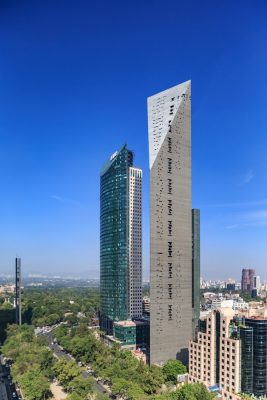
(c) Alfonso Merchand
The 246-meter tower was recognized as a CTBUH 2016 Awards finalist for the Americas region for its innovative structural configuration, significant opacity along one of its façades, and the preservation of a historic building at its base. The tower is now the tallest building in Mexico.
Completions by Function
Interestingly, the functional split for tall building completions in 2016 remains almost perfectly consistent with that of previous years. Office functions have by far the highest share, representing 52% of completions with 67, achieving a consecutive all-time record over 2015, in which there were 53. Meanwhile, 38 mixed-use buildings were completed, representing 30% of the total; while 20 residential buildings came online with a share of 16%. Only three all-hotel towers were completed in 2016, representing just 3% of the total. Given that hotel functions are critical components of many mixed-use developments, the low number of completions for hotel-only towers does not indicate a downward trend for the function altogether.
Completions by Structural Material
The number of buildings completed in 2016 with composite structural systems hit an all-time high this year, with 68, or 53% of the total. Composite construction represents an effort to use the optimal properties of steel and concrete and counteract their respective weaknesses.
Thus, this material trend is expected to continue to dominate, particularly as tall buildings continue to proliferate in seismically active regions like China, which mandate robust structural responses. Concrete construction took the remaining share of completions with 58, or 45% of the total.
The significant use of concrete can be attributed to a combination of concrete’s relative ubiquity and lower cost in many regions, as well as its comparative simplicity in construction, which would increase its appeal in regions with lower-skilled labor pools.
In 2016, not a single building of 200 meters or higher was completed with an all-steel structural system. The use of steel in tall buildings has almost completely transitioned into composite construction. As of this writing, there are only nineteen 200-meterplus buildings currently under construction that employ all-steel structural systems.
The World’s 100 Tallest Buildings: Impact of 2016
Back in 2015, 14 buildings entered the list of the World’s 100 Tallest Buildings, marking the first year that every building on the 100 Tallest list was a supertall (300-plus meters tall). It follows that all 10 buildings entering the list in 2016 also lie above this threshold, increasing the average height of the 100 tallest buildings from 357 meters in 2015 to 362 meters in 2016. The shortest building on the list is now Leatop Plaza, Guangzhou, at 303 meters.
Mixed-use functions continue to enjoy a plurality in the 100 Tallest list, with 41 buildings, the same count as in 2015.
Meanwhile, office functions take a slightly greater share in 2016 with 40 buildings, up from 38 in 2015. Residential and hotel functions have smaller shares, with 12 and seven buildings, respectively.
The 100 Tallest list continues to be dominated by composite construction, with 53 buildings now employing composite systems, up from 46 in 2015. All-concrete and steel primary structures have experienced slight losses, down to 34 buildings for concrete and nine for steel.
Analysis
For the third year running, the world has built more 200-meter-plus buildings than any other year (128), beating the previous record of 114 in 2015. In 2015, we predicted that between 110 and 135 buildings would complete within this range in 2016, so it comes as no surprise that it was yet another record-breaking year in the skyscraper industry.
It’s impossible to decouple the enormous boom in global skyscraper construction from the rapid urban development of China.
Additionally, over the past several years, there has been a major uptick in the amount of real estate investment coming out of China, rather than remaining within it. This, in combination with a still-cooling national economy, has caused some to assume that the nation’s era of unprecedented construction is on the decline. While that may be the case in the long run, short-term prospects remain high, with 328 buildings in the 200-plus-meter range currently under construction in the country.
It’s safe to say that the role of the tall building in China will never truly fade; the only question that remains is how long it will continue to keep a majority share of tall building completions annually. With the closest national contender, the US, in 2016 having only seven completions and China having 84, it’s clear that the gap will take a number of years to close, if it ever does. Perhaps the most indicative trend from this report highlighting China’s status is the fact that the city of Shenzhen completed 11 buildings that were 200 meters or higher.
This is more than any country other than China managed to complete. With nine of these buildings accommodating pure office functions, and the remaining two combining office and either hotel or residential, the priorities for Shenzhen are clear: These buildings are strategic endeavors to stimulate the local and national economy with commerce, some of it originating internationally as a result of Shenzhen’s status as a Special Economic Zone.
The ethos is still very much in the realm of “if you build it, they will come;” we’ll just have to wait and see if the wager is fruitful.
“Tallest” titles also reigned supreme in 2016, with 18 completed buildings becoming the tallest in a city, country, or region.
MahaNakhon tower building:
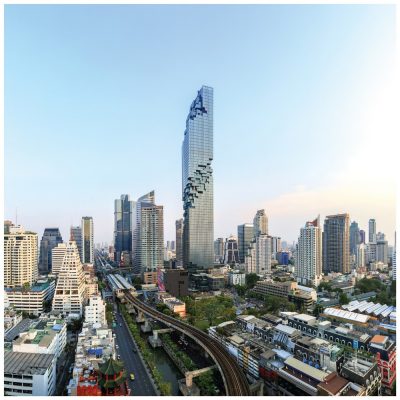
(c) PACE Development
These superlatives include: Vostok Tower (374 meters) completed to become the tallest building in Russia and Europe; MahaNakhon (314 meters) completed as the tallest building in Thailand; Guangzhou CTF Finance Centre (530 meters) completed as the tallest building in Guangzhou, the second-tallest in China, and the fifth-tallest in the world; Torre Reforma (246 meters) became the tallest in Mexico; Tajong Pagar Centre (290 meters) is now the tallest in Singapore; Gama Tower (286 meters) became the tallest in Indonesia; The Crescent City (210 meters) became the tallest building in Azerbaijan;
Eton Place Dalian Tower 1 (383 meters) completed as the tallest building in Dalian, China; Tianjin Modern City Office Tower (338 meters) became the tallest in Tianjin, China; Wanda Plaza 1 and 2 (307 meters) completed as the tallest in Kunming, China; Greenland Center Tower 1 (270 meters) became the tallest in Xi’an, China; Huayuan Center Tower 7 (270 meters) completed as the tallest building in Changsha, China; Golden Eagle Plaza (252 meters) is now the tallest building in Kunshan, China; Poly Business Center Office Tower (248 meters) completed as the tallest is Foshan, China; World Trade Center 1 (215 meters) became the tallest building in Yiwu, China;
Grand Hyatt Metrocenter (258 meters) completed as the tallest building in Taguig City, Philippines; and Ilsan Yojin Y-City Tower 105 (230 meters) completed to become the tallest building in Goyang, South Korea.
In each instance, the drivers behind these buildings remain constant: the desire to establish identity (whether for a commercial business or an entire locale), to enhance the skyline, to respond to urban population growth, and to maximize functional utility upon minimal land area.
A Postscript on 2017
Perhaps one of the hidden narratives this year is what didn’t complete, rather than what did.
Many of the supertalls the Council now projects to complete in 2017 are carryovers from 2016. Only 10 of the 18 to 27 supertalls projected by the Council in 2015 to complete in 2016 actually did complete.
Taking this into account, yet also acknowledging the massive number of supertalls in advanced stages of construction, we expect between 12 and 20 supertall buildings to complete in 2017, primarily in Asia and the Middle East.
The tallest building set to complete in 2017 is Ping An Finance Center, which at 599 meters will take its place as the tallest building in Shenzhen, the second-tallest in China, and the fourth-tallest in the world. Ping An was initially predicted to be the tallest completion in 2016, but the time needed to put the final touches on the tower caused it to slip into 2017. In South Korea, Lotte World Tower is also set to complete in Seoul, rising 555 meters and taking its position as the tallest in the country by a wide margin.
The tower is programmed with a greater variety of functions than is normally found in a tall building. It contains retail components, offices, a seven-star luxury hotel, and an “officetel” – a function common in South Korean real estate, which offers studio-apartment style accommodations for people who work in the building. Meanwhile, the building’s top 10 stories are earmarked for extensive public use and entertainment facilities, including an observation deck and rooftop café.
CTBUH Annual Review 2016 images / information from CTBUH
Location: Chicago, IL, USA
CTBUH Awards 2016
CTBUH Awards
Best Tall Building Worldwide
– Shanghai Tower
Shanghai, China
Best Tall Building Americas
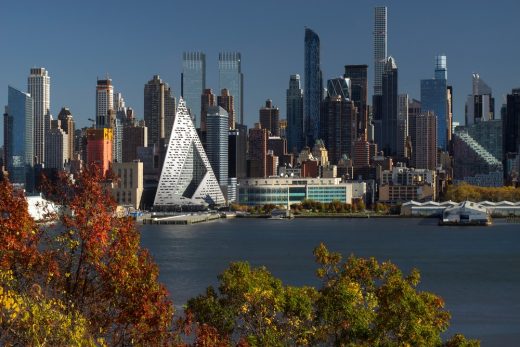
photo © Nic Lehoux
– VIA 57 West
New York City, USA
Best Tall Building Asia & Australasia
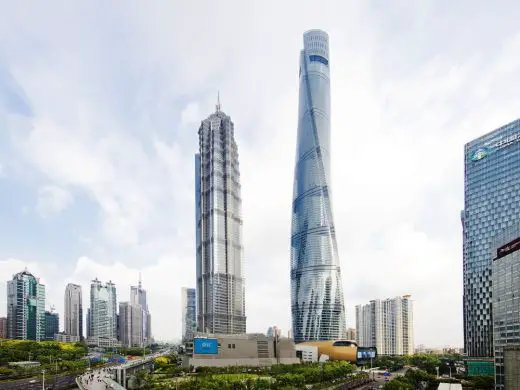
photo © Connie Zhou
– Shanghai Tower
Shanghai, China
Best Tall Building Europe
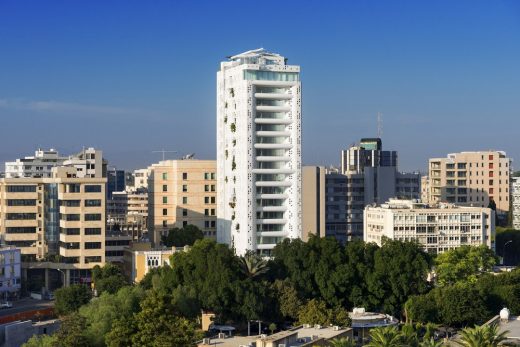
photo © Yiorgis Yerolymbos, courtesy of Nice Day Developments
– The White Walls
Nicosia, Cyprus
Best Tall Building Middle East & Africa
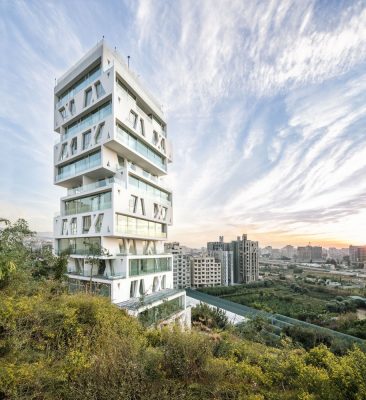
photo © Matthijs van Roon
– The Cube Tower
Beirut, Lebanon
Urban Habitat Award
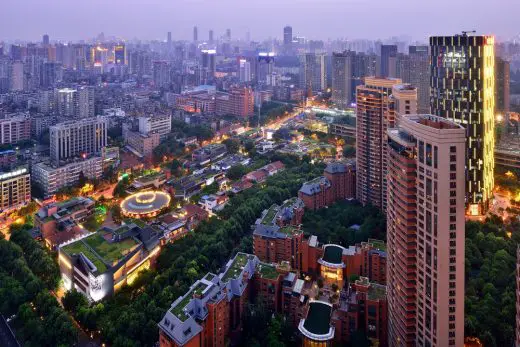
photo © Shui On Land
– Wuhan Tiandi Site A
Wuhan, China
10 Year Award
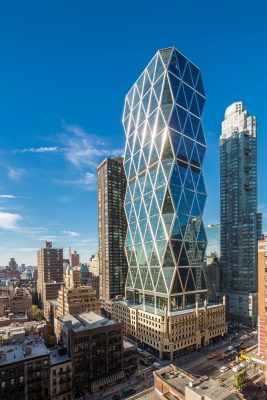
photo © Hearst Corporation
– Hearst Tower Building
New York City, USA
Innovation Award

image © SOM
– Pin-Fuse Seismic System
Performance Award
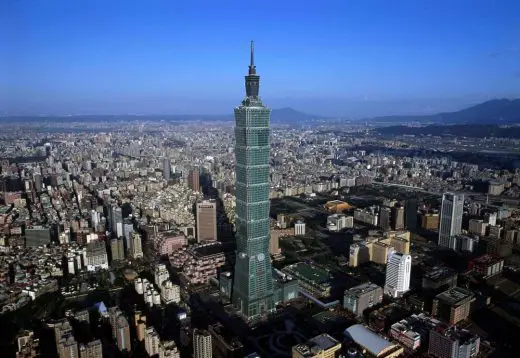
photo © Taipei Financial
– Taipei 101 Tower Building
Taipei, Republic of China (Taiwan)
2016 CTBUH Awards Winner – Shanghai Tower
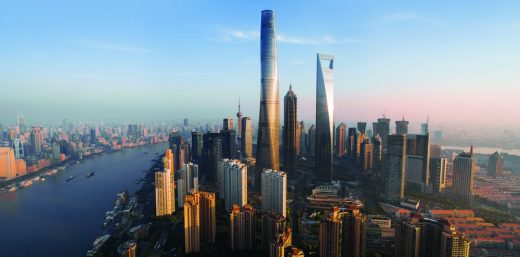
photo © Gensler
The full list of 2016 CTBUH Awards Winners and Finalists can be found here:
Aqua Tower Chicago – designed by Studio Gang Architects:
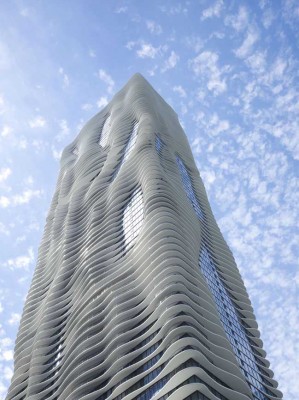
image from architects
The Gherkin Wins CTBUH 10 Year Award
30 St. Mary Axe, London, United Kingdom, popularly known as “The Gherkin.”
The Gherkin
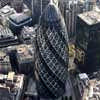
photo © webbaviation
CTBUH Events : Congress 2012 in Shanghai, China
CTBUH Awards : Dinner / Ceremony / Symposium
CTBUH Best Tall Building Overall – 2010 : Burj Khalifa
World Skyscrapers – Selection
Burj Dubai, Dubai
Guangzhou TV Tower, China
CTBUH Best Tall Building Middle East & Africa – The Cube, Beirut, Lebanon
Empire State Building, New York
Absolute Tower, Canada
CTBUH Best Tall Building Overall 2010 : Burj Khalifa Dubai
Comments / photos for the CTBUH Annual Review 2016 page welcome

